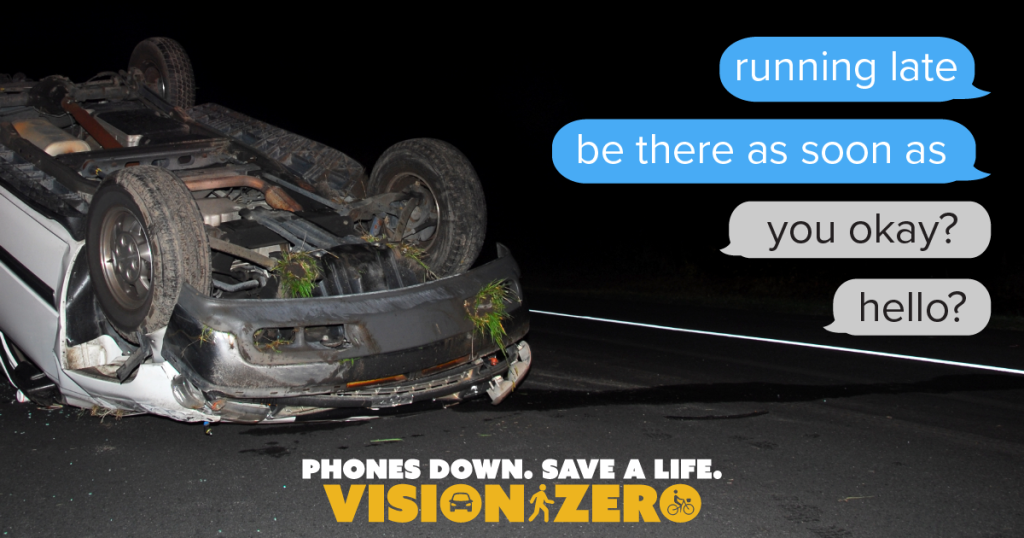Distractions don’t just cause crashes… they make them worse

Using your cell phone while driving is not only a bad idea, it’s also illegal in many cases. Austin has an ordinance banning cell phone use[FJ1] while driving unless using a hands-free device, and Texas law prohibits texting while driving.
But why are these laws necessary? What happens when the rubber literally meets the road … but your eyes leave it?
Earlier this year, Cambridge Mobile Telematics (CMT) released The State of US Road Risk in 2024, a data-driven analysis of various dangers on the road, including distracted driving. CMT is a software company that studies anonymized vehicle and cell phone data to determine the causes of crashes and suggest safety improvements. This was the fifth edition of the analysis that CMT has published.
The report contains two key assertions: Distracted driving can be a factor in car crashes; and it can increase the severity of crashes.
It seems obvious that taking one’s eyes off the road increases the risk of a crash, but CMT supported this with a startling number: 34 percent of all crashes studied happened within one minute of distracted driving.
Other research supports this idea. According to the Insurance Institute for Highway Safety (IIHS), studies have consistently shown that texting or otherwise manipulating a cellphone increases crash risk by two to six times.
All automobile crashes are a bad thing, regardless of cause. But some are worse than others, and CMT’s analysis suggests that distraction-caused crashes have an element that makes them more dangerous: speed. Not only does distraction cause crashes, but it also delays driver reactions to the impending crash. The distracted driver is later to swerve or brake, meaning the speed at impact will be higher.
The type of distraction matters, too. Across the crashes studied by CMT, hands-free calls, although safer than other situations, still led to 9 percent higher impact speeds than in non-distraction crashes. Interacting with a screen (tapping to dial, texting, playing a video, etc.) resulted in a 21 percent speed increase, phone motion (reaching for the phone) caused a 27 percent speed increase and handheld calls led to a 31 percent speed increase.
Translating that into concrete numbers, CMT offered this scenario: Let’s say a driver (not distracted) is traveling at 40 miles per hour and the car in front of them stops too suddenly to avoid a crash. After slamming the brakes, the driver of the trailing car hits the stopped car at 30 mph. But if that driver has one of the following distractions, their speed would be:
- Hands-free phone: 33 mph
- Texting: 36 mph
- Grabbing the phone: 38 mph
- Handheld phone call: 39 mph
Those differences in speeds might not seem like much, but CMT cites IIHS studies showing that driving just 5 mph faster can cause a rise in fatalities of 3 to 8 percent. In Seattle, lowering speed limits from 30 mph to 25 mph resulted in a 20 percent drop in serious injuries and deaths.
Speed is an even greater factor when an automobile hits a human body. According to the AAA Foundation for Traffic Safety, the average risk for severe injury when a vehicle hits a pedestrian reaches 10% at an impact speed of 16 mph, 25% at 23 mph, 50% at 31 mph, 75% at 39 mph, and 90% at 46 mph. The average risk of death for a pedestrian reaches 10% at an impact speed of 23 mph, 25% at 32 mph, 50% at 42 mph, 75% at 50 mph, and 90% at 58 mph.
Of course, electronic devices aren’t the only cause of distracted driving. A study published in the New England Journal of Medicine found that eating while driving can increase the chances of crashing by three times for younger drivers. Applying makeup, adjusting the radio and talking to passengers, among other activities, can also be causes of distraction.
So keeping your hands free helps, but as shown above, even hands-free devices carry some risk. The safest way to drive is free of distractions: phone down, eyes up.

